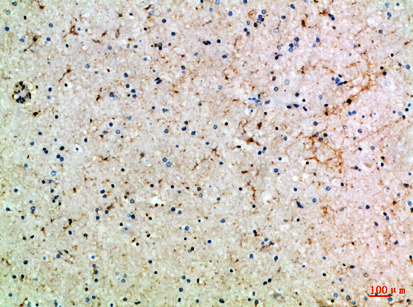ASIC1 Polyclonal Antibody
- 产品详情
- 实验流程
- 背景知识
Application
| WB, IHC-P |
|---|---|
| Primary Accession | P78348 |
| Reactivity | Human, Mouse, Rat |
| Host | Rabbit |
| Clonality | Polyclonal |
| Calculated MW | 59909 Da |
| Gene ID | 41 |
|---|---|
| Other Names | Acid-sensing ion channel 1 (ASIC1) (Amiloride-sensitive cation channel 2, neuronal) (Brain sodium channel 2) (BNaC2) |
| Dilution | WB~~WB 1:500-2000,IHC-p 1:500-200, ELISA 1:10000-20000 IHC-P~~WB 1:500-2000,IHC-p 1:500-200, ELISA 1:10000-20000 |
| Format | Liquid in PBS containing 50% glycerol, 0.5% BSA and 0.09% (W/V) sodium azide. |
| Storage Conditions | -20℃ |
| Name | ASIC1 (HGNC:100) |
|---|---|
| Function | Forms voltage-independent, pH-gated trimeric sodium channels that act as postsynaptic excitatory receptors in the nervous system, playing a crucial role in regulating synaptic plasticity, learning, and memory (PubMed:21036899, PubMed:32915133, PubMed:34319232). Upon extracellular pH drop this channel elicits transient, fast activating, and completely desensitizing inward currents (PubMed:21036899). Displays high selectivity for sodium ions but can also permit the permeation of other cations (PubMed:21036899). Regulates more or less directly intracellular calcium concentration and CaMKII phosphorylation, and thereby the density of dendritic spines. Modulates neuronal activity in the circuits underlying innate fear (By similarity). |
| Cellular Location | Cell membrane; Multi-pass membrane protein Postsynaptic cell membrane {ECO:0000250|UniProtKB:Q6NXK8}. Cell projection, dendrite {ECO:0000250|UniProtKB:Q6NXK8}. Note=Isolated in synaptosomes from the dendritic synapses of neurons {ECO:0000250|UniProtKB:Q6NXK8} |
| Tissue Location | Expressed in neurons throughout the central and peripheral nervous system. |
For Research Use Only. Not For Use In Diagnostic Procedures.
Provided below are standard protocols that you may find useful for product applications.
BACKGROUND
Isoform 2 and isoform 3 function as proton-gated sodium channels; they are activated by a drop of the extracellular pH and then become rapidly desensitized. The channel generates a biphasic current with a fast inactivating and a slow sustained phase. Has high selectivity for sodium ions and can also transport lithium ions with high efficiency. Isoform 2 can also transport potassium, but with lower efficiency. It is nearly impermeable to the larger rubidium and cesium ions. Isoform 3 can also transport calcium ions. Mediates glutamate-independent Ca(2+) entry into neurons upon acidosis. This Ca(2+) overloading is toxic for cortical neurons and may be in part responsible for ischemic brain injury. Heteromeric channel assembly seems to modulate channel properties. Functions as a postsynaptic proton receptor that influences intracellular Ca(2+) concentration and calmodulin-dependent protein kinase II phosphorylation and thereby the density of dendritic spines. Modulates activity in the circuits underlying innate fear.
终于等到您。ABCEPTA(百远生物)抗体产品。
点击下方“我要评价 ”按钮提交您的反馈信息,您的反馈和评价是我们最宝贵的财富之一,
我们将在1-3个工作日内处理您的反馈信息。
如有疑问,联系:0512-88856768 tech-china@abcepta.com.























 癌症的基本特征包括细胞增殖、血管生成、迁移、凋亡逃避机制和细胞永生等。找到癌症发生过程中这些通路的关键标记物和对应的抗体用于检测至关重要。
癌症的基本特征包括细胞增殖、血管生成、迁移、凋亡逃避机制和细胞永生等。找到癌症发生过程中这些通路的关键标记物和对应的抗体用于检测至关重要。 为您推荐一个泛素化位点预测神器——泛素化分析工具,可以为您的蛋白的泛素化位点作出预测和评分。
为您推荐一个泛素化位点预测神器——泛素化分析工具,可以为您的蛋白的泛素化位点作出预测和评分。 细胞自噬受体图形绘图工具为你的蛋白的细胞受体结合位点作出预测和评分,识别结合到自噬通路中的蛋白是非常重要的,便于让我们理解自噬在正常生理、病理过程中的作用,如发育、细胞分化、神经退化性疾病、压力条件下、感染和癌症。
细胞自噬受体图形绘图工具为你的蛋白的细胞受体结合位点作出预测和评分,识别结合到自噬通路中的蛋白是非常重要的,便于让我们理解自噬在正常生理、病理过程中的作用,如发育、细胞分化、神经退化性疾病、压力条件下、感染和癌症。







